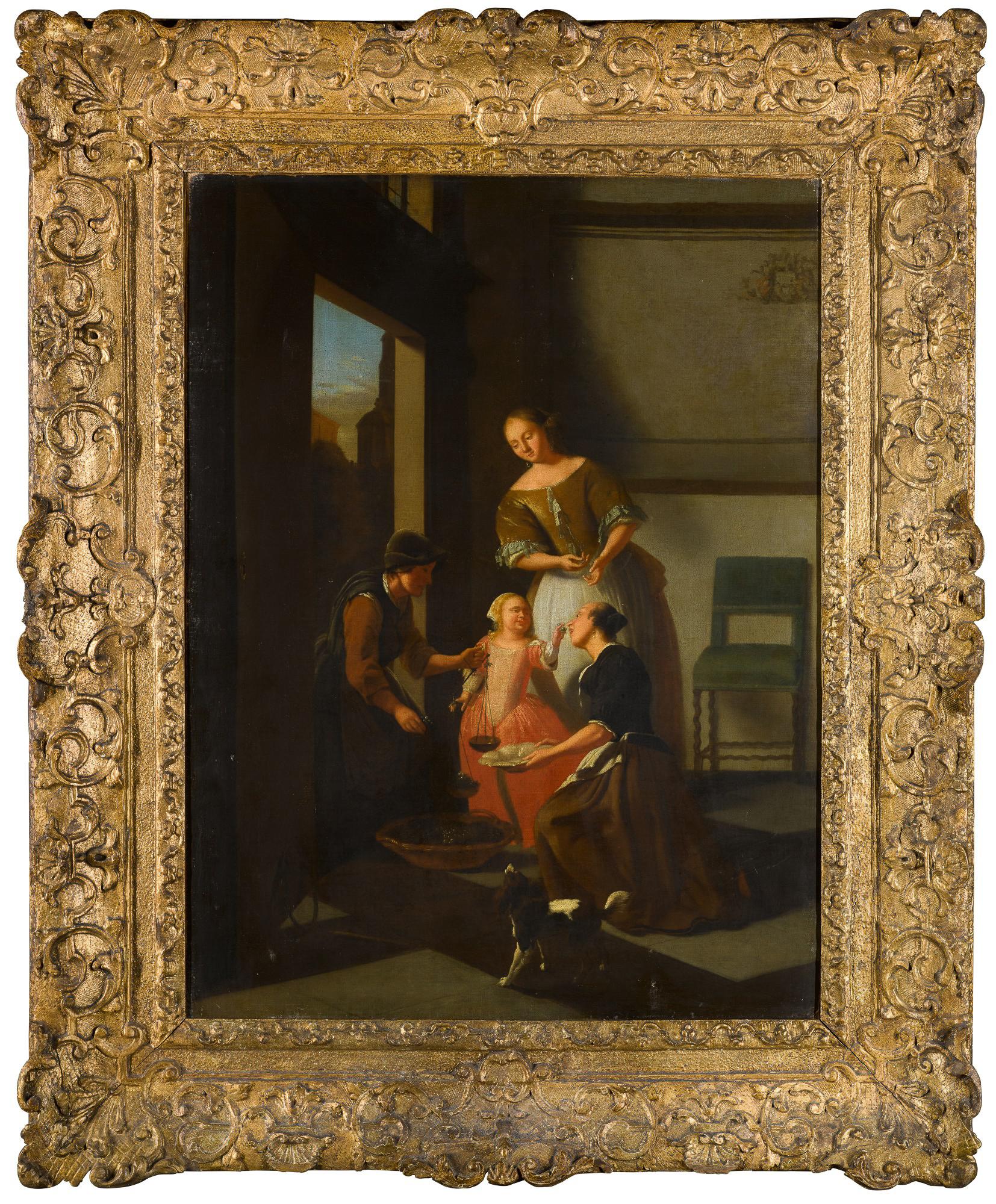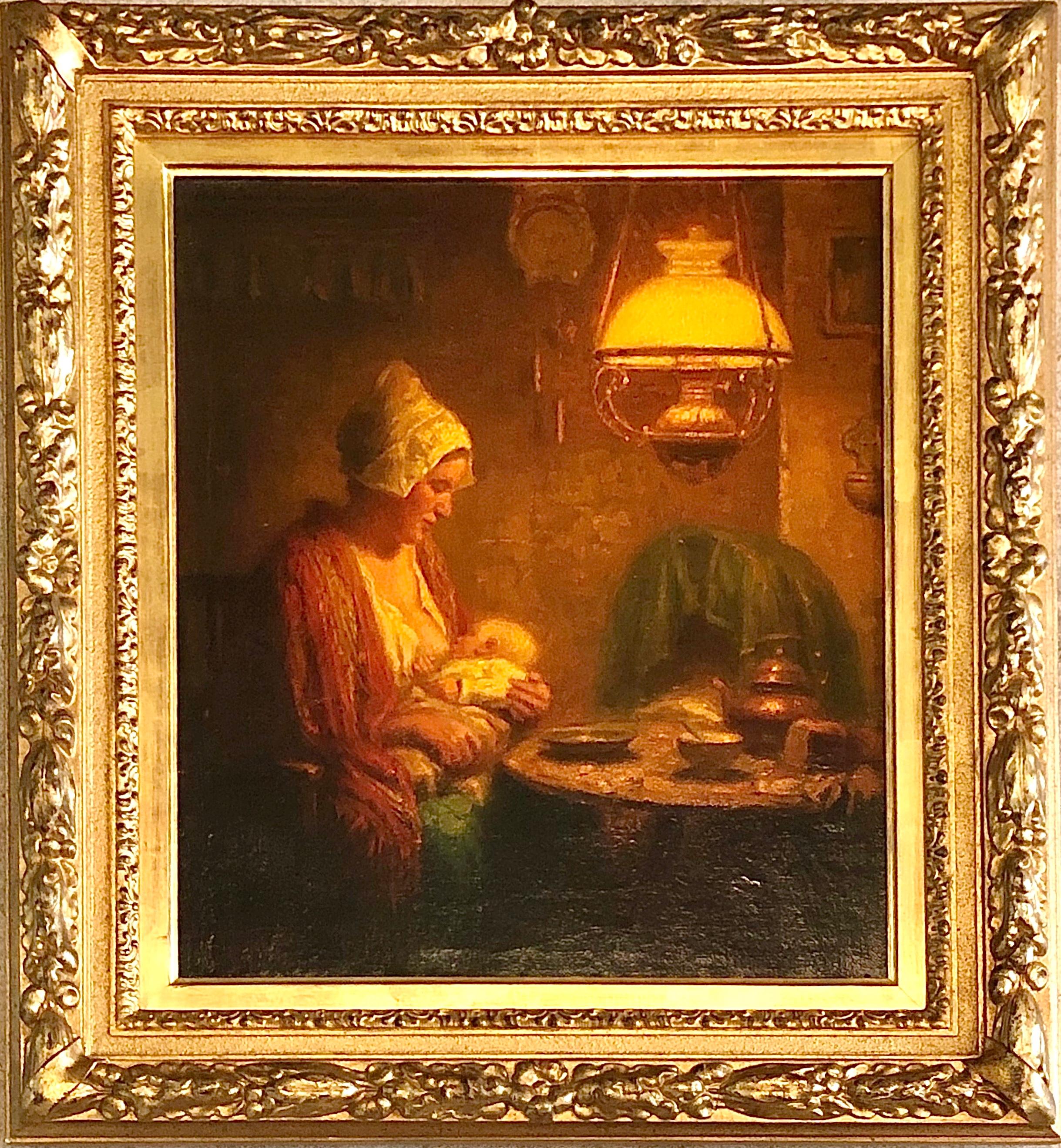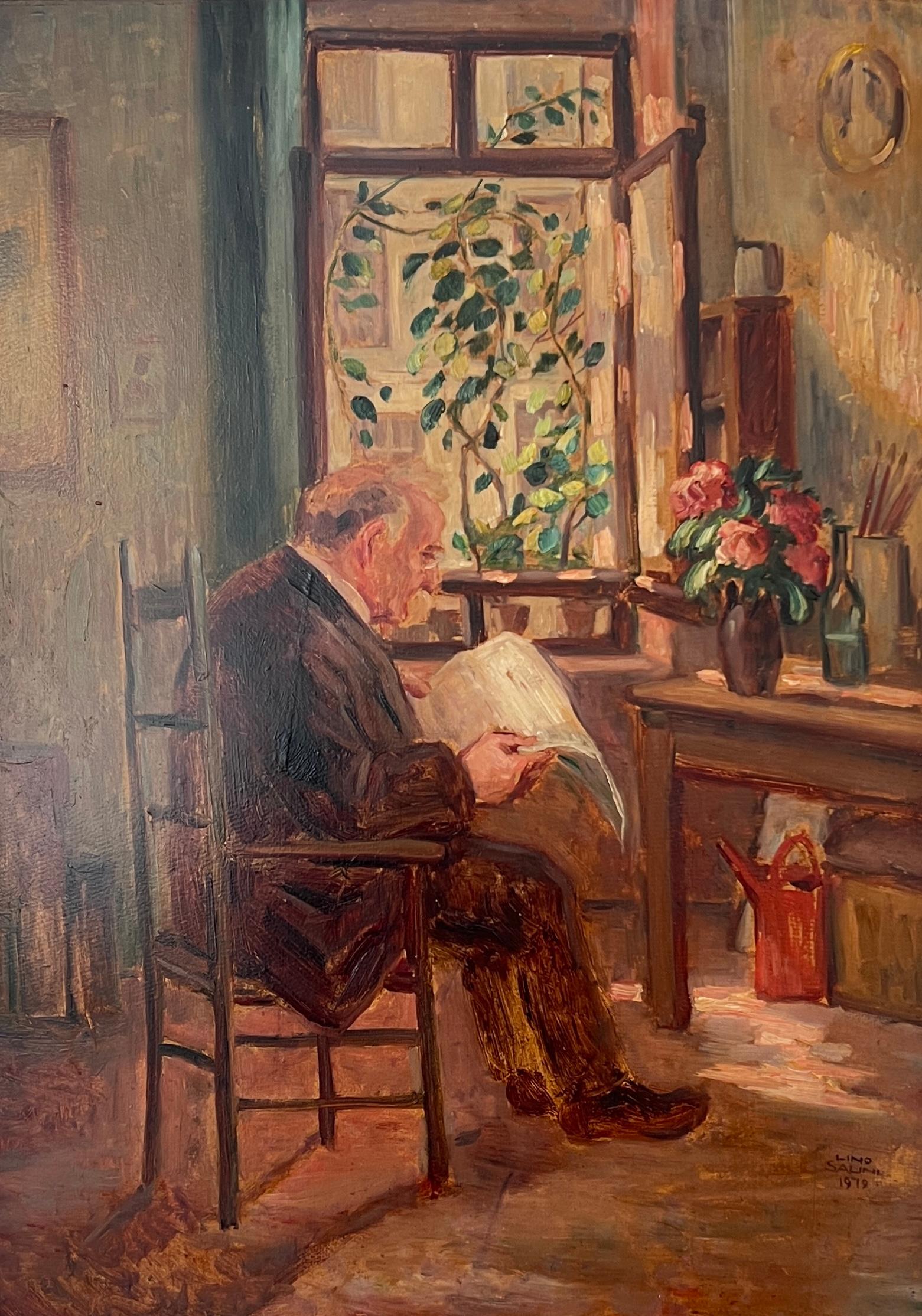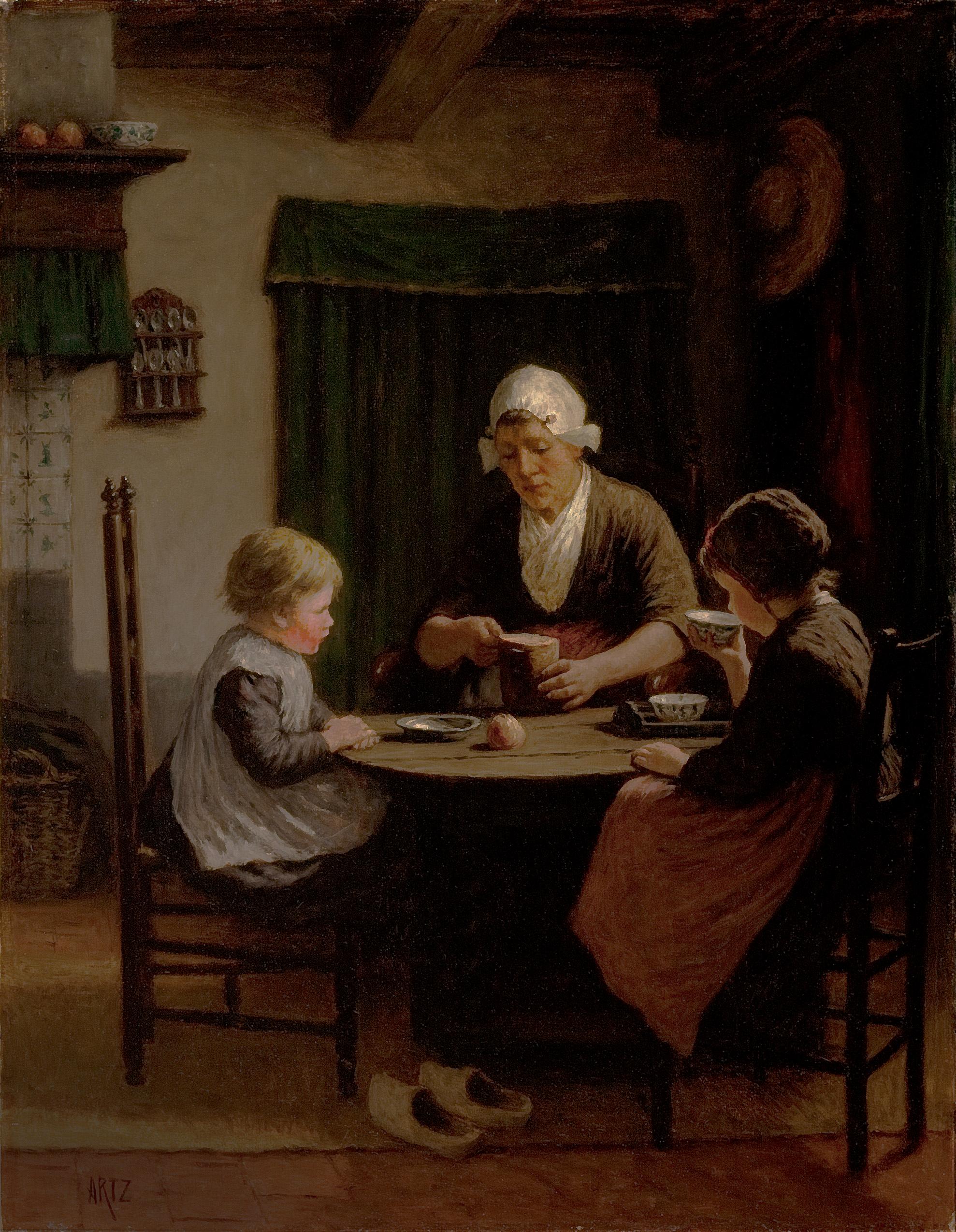Items Similar to Interior with gathering of musicians
Want more images or videos?
Request additional images or videos from the seller
1 of 6
Anthonie PalamedeszInterior with gathering of musiciansca 1635
ca 1635
About the Item
(1601, Delft – 1673, Amsterdam)
Interior with gathering of musicians.
Circa 1635.
Oil on panel. 59.3 x 82 cm.
Provenance
Jules Porgès Collection, Paris , 1911.
Fine Art Gallery H. G. Klein, Cologne, 1981.
European Private Collection.
Literature
Armand Dayot. Grands et Petits Maitres Hollandais. Ed. Georges Petit /F. Kleinberger, Paris, 1911. P. 11. Nr.119.
Exhibited
Grands et Petits Maitres Hollandais. Les salles de Jeu de Paume. July, 1911.
The work is registered in the RKD database under the number 206935 as dated around 1635.
This beautiful painting by Anthonie Palamedesz comes from the collection of Jules Porgès (1839 - 1921), a well-known Parisian financier, a banker, who played a major role in the development of gold mining and diamond mines in South Africa.
Porzhes made a significant collection of Old Masters, partly situated in his Parisian mansion on Montague street, partly in a castle, the previously-owned family of La Rochefoucauld, in a suburb of Paris, a place called Rochefort-en-Yvlin. He collected mosltly Dutch and Flemish artists of the Gold 17th century. In the collection of Porzhes there was another work by Anthony Palamedes "The Lady Playing the Harpsichord".
The work raffigures the noble society gathering in an interior. The figure of the boy on the right is the artist's favorite motif, to be found in many of his paintings. It appears in the middle of 1635 and keeps being in the Palamedes paintings until the 1640s. A work close to th epresent with the same motive of a men sitting with his back against the light and a servant boy pouring the vine into hi glass was sold at Rudolf Lepke Auction in 1918 (05.07.08, lot 38; wood, 58 x 75 cm oil). In addition to that, there is a work of a similar size with the present painting, dated 1640 (Kersttentoonstelling 1929-1930, Museum Boijmans Van Beuningen, Rotterdam (geotrefw), 1929-1930, No. 9,). In the paintings of 1635, as in the present work, Palamedes concentrated on the figures of people, always carefully painted, often these are the portraits of his c contemporaries. These years, figures of people occupy the whole space of the picture, from the first plan, then the artist expanded the space, the figures became smaller and occupied only middle distant plans.
- Creator:Anthonie Palamedesz (1601 - 1673)
- Creation Year:ca 1635
- Dimensions:Height: 23.35 in (59.3 cm)Width: 32.29 in (82 cm)
- Medium:
- Movement & Style:
- Period:1630-1639
- Condition:
- Gallery Location:Tallinn, EE
- Reference Number:1stDibs: LU2243213497282
About the Seller
No Reviews Yet
Vetted Seller
These experienced sellers undergo a comprehensive evaluation by our team of in-house experts.
Established in 2018
1stDibs seller since 2022
Typical response time: 14 hours
- ShippingRetrieving quote...Ships From: Tallinn, Estonia
- Return PolicyA return for this item may be initiated within 2 days of delivery.
More From This SellerView All
- A tavern interior with a dog and kitchen utensils in the foregroundBy David Teniers the YoungerLocated in Tallinn, EEDavid Teniers, the Younger (1610, Antwerp – 1690, Brussels) A tavern interior with a dog and kitchen utensils in the foreground. Signed lower left: TENIERS F. Oil on panel. 28 x 36,2...Category
17th Century Dutch School Still-life Paintings
MaterialsOil, Canvas
- A winter landscape with huntersLocated in Tallinn, EEHendrikus van de Sande Bakhuyzen (The Hague 1795-1860) A winter landscape with hunters on a path along a stream Signed and dated 'H vd S. Bak...Category
1820s Dutch School Figurative Paintings
MaterialsCanvas, Oil
- A tavern interior with a dog and kitchen utensilsBy David Teniers the YoungerLocated in Tallinn, EEA tavern interior with a dog and kitchen utensils in the foreground. Signed lower left: TENIERS F. Oil on panel. 28 x 36,2 cm. Attribution RKD, the Hague Provenance Private collectio...Category
17th Century Dutch School Still-life Paintings
MaterialsCanvas, Oil
- Portrait of a lady in a lace collar.By Circle of Paul van SomerLocated in Tallinn, EEPaul van Somer, circle of (1576, Antwerp - 1621, London) Portrait of a lady in a lace collar. Oil on panel. 64 x 49.5 cm. Provenance Private collection, Switzerland The present...Category
17th Century Flemish School Portrait Paintings
MaterialsOil, Panel
- The Dusty DoorknobBy Patrick HughesLocated in Tallinn, EE”The Dusty Doorknob”. 2000 Titled, signed and dated on the reverse in black felt-tip pen: The Dusty Doorknob Patrick Hughes 2000. Oil on panel, relief. 64,8 × 160 × 16 cm (82,5 × 17...Category
Early 2000s Op Art Landscape Paintings
MaterialsOil, Panel
- A river landscape with travellers by a jetty and a man in a rowing boatBy David Teniers the YoungerLocated in Tallinn, EEDavid Teniers the Younger Antwerp 1610 - 1690 Brussels A river landscape with travellers by a jetty and a man in a rowing boat, a church beyond Signed with monogram lower right: DT. ...Category
17th Century Flemish School Landscape Paintings
MaterialsPanel, Oil, Oak
You May Also Like
- The Grape Seller by Jacob Ochtervelt (Workshop), Oil on Canvas, Period FrameLocated in Stockholm, SEJacob Ochtervelt (Workshop) The Grape Seller There are two known versions of this subject. This is a reduced variant of Ochtervelt's signed and dat...Category
1660s Dutch School Interior Paintings
MaterialsCanvas, Oil
- Interior and pipe smokerLocated in Genève, GEWork on wood Brown wooden frame 49 x 58 x 4 cmCategory
Late 18th Century Dutch School Interior Paintings
MaterialsOil
- Feeding the BabyLocated in Wiscasett, MEOil on canvas, signed upper left. Provenance: Sothebys Amsterdam, Private collection London, Private collection Palm Beach. His working period was from about 1894 to 1973, successively in Rotterdam, Heeze (Heeze-Leende), Hilversum and Laren. He was educated at the Craft School for decorative painters and received evening lessons at the Rotterdam Academy under the direction of A. van Maasdijk. He was a member of the Vereeniging Sint Lucas...Category
Early 20th Century Dutch School Interior Paintings
MaterialsOil
- Classical Dutch Interior Still Life Painting of a Water Jug, Fruit, and TapestryLocated in Houston, TXClassical still life painting of a metal water jug, a collection of various fruits, and an ornate tapestry beautifully executed in the Dutch school style. Signed by the artist in the lower left corner. Currently framed in a complimentary gold and black frame with a thin green matte. Dimensions Without Frame: H 19 in. x W 23 in. Artist Biography: Eduard Peter Moleveld was born in the Netherlands in 1946. He is primarily known for his realistic Dutch style still life...Category
Mid-20th Century Dutch School Still-life Paintings
MaterialsOil
- Character reading the newspaperLocated in Genève, GEWork on cardboard Golden wooden frame 79 x 59 x 2.5 cmCategory
1910s Dutch School Interior Paintings
MaterialsOil
- At Grandmother’sLocated in New York, NYsigned in the lower left Artz oil on canvas 26 x 19 ⅝ inches (66 x 50 cm.) PROVENANCE D. Sala & Zonen, Leiden , prior to 1936 Private Collection, Florida, circa 1968 until the present time Much like their seventeenth century counterparts, a group of painters known as the Hague School in the 1870s came to embrace as their subject matter the native Dutch landscape and the everyday lives of its rural inhabitants, most notably the fisher folk of the coastal villages. Within ten years the Hague School artists’ works would prove so popular that incredibly a mania for all things Dutch would be felt throughout the world, and would dominate the art in Holland until well after the turn of the century. By embracing simple themes remarkable for their ordinariness, the Hague School succeeded in striking a chord with a public whose own placidity was constantly being rattled by the evolving modernity of the times. Conveyed through the employment of subtle tones, hazy skies and subjects of happenstance their mix of nostalgia and realism enchanted viewers. The Hague became the center of the movement because it was semi-rural surrounded by meadows, polders, waterways, dunes and woods, and nearby Scheveningen provided a wealth of material for artists seeking to paint the shore and its fishing community. Jozef Isräels was considered the dean of the Hague School and David Adolphe Constant Artz his most important follower. Artz began his training in 1855 at the Amsterdam Academie under Louis Roijer and Johannes Egenberger, and would remain in Amsterdam until 1864. During this period, he would be influenced by August Allebé but more importantly a lifelong friendship with Jozef Israëls formed. In 1859 they traveled together to Zandvoort. He would also be the first of the Hague School artists to follow Isräels’ lead of working on the beach at Scheveningen. In 1859 Artz publically exhibited for the first time, taking part in the Tentoonstelling von Levende Meesters (Exhibition of Living Masters). In 1864 he left Amsterdam to live in Zweeloo, Drenthe for a year. From 1866 until 1874 he shared a studio with Jacob Maris and Frederick Hendrik Kaemmerer. He was one of the first of the Hague School artists to work in Paris (Jacob Maris having preceded him by one year) enabled by his patron and benefactor Johannes Kneppelhout. Artz created quite a commotion upon his arrival by including in his baggage a large collection of Scheveningen peasant costumes. As previously in Holland, Artz during his sojourn in Paris continued to paint beach scenes and interior views that featured the fishing communities of the North Sea. During this period Artz became interested in Japanese prints which had recently become available in Paris, and painted a few genre scenes of interiors with Japanese décor and subjects. While based in Paris he also traveled to Scotland from May-June 1869, Germany in November of that year, England in 1870 and Italy in January, 1872. By 1874 he returned to the Netherlands to live permanently in The Hague. Artz in his own time was held in high esteem by the public as well as his fellow artists. He was awarded gold medals at exhibitions in Munich and Vienna, as well as a Diploma and Medal of Honor in Dresden. In 1879 he was made Knight of the Oaken Crown of Luxembourg and in 1889 also became a Knight of the Order of St. Michael of Bavaria. In 1880 he received an Honorable Mention at the Salon in Paris and won a gold medal in 1883 at the International and Colonial Exhibition, Amsterdam. In Paris he was a member of the Société Nationale des Beaux Arts and a Chevalier of the Legion of Honor by 1889. He also served as Vice President of the International Jury of Award at the 1889 Exposition Universelle, Paris. In 1893 four works by Artz were chosen to be included in the World’s Columbian Exposition, Chicago. An American reviewer wrote of this show “The works of giants like Rembrandt, Van der Neer, Ruysdael, Holbein and Franz Hals are almost equaled now by masters like Israels, Mesdag, Bosboom, Maris, Mauve and Artz”. Artz’s entries A Girl Knitting, The Pet Lamb, Idle Hours on the Dunes and Girl Sleeping on the Dunes were listed under the category of “Immortal Works”. His works formed part of museum collections of Amsterdam (Rijksmuseum and Municipal Museum); Cambridge, England; Chicago; Dordrecht; Glasgow; Haarlem; The Hague (Gemeentemuseum and Mesdag Museum); Leewarden; Montreal; New York (Brooklyn and the Metropolitan Museum); Oxford; Rotterdam; St. Louis; Tulsa and Zandvoort. Much enamored with the picturesque dwellings of the rural population, a favorite subject of the Hague School was the depiction of a family group gathered around a table sharing a simple meal. Ronald de Leeuw in his introduction for The Hague School Book remarked that the group “derived poetry from a view of the kitchen”. Artz excelled at this type of interior scene in which every detail has been carefully recorded in emulation of his seventeenth century predecessors. Vincent van Gogh, an admirer of the Hague School in general and Artz in particular, wrote to his brother Theo in a letter dated Etten, Friday, August 26, 1881 about an exhibition in The Hague he had just visited in which he described a drawing by Artz of an “old man and woman eating porridge, very important, very good and serious.” There is a large version of At Grandmother’s (131.5 x 91.5 cm.) in the Rijksmuseum, Amsterdam. It was painted in 1883 and shown in an exhibition in The Hague in 1884 where it was purchased by the museum. This undoubtedly must have sparked interest in the composition and created a demand for the image to be replicated as several versions of the composition in varying sizes are recorded, and Artz was known for executing repetitions of his own works. Regarded as one of the highlights of the collection in the Philbrook Museum of Art in Tulsa, Oklahoma is another version by Artz of At Grandmother’s. The iconic nature of the image must have appealed to contemporaries as the perfect summation of the mix of idealism and realism that characterized these artists and their times. In a cottage under a wooden beamed ceiling a grandmother with her two granddaughters clothed in the traditional garb of Katwijk (where the artist spent his summers and maintained a cottage in the dunes) sit on wooden chairs around a gate-leg table in a kitchen sharing a simple meal of bread and an apple. The grandmother carefully slices a piece of bread while the younger girl looks on expectantly. Her sister sips milk from a small delftware bowl watching...Category
Mid-19th Century Dutch School Interior Paintings
MaterialsOil




